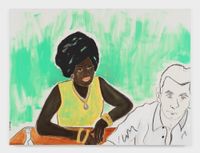
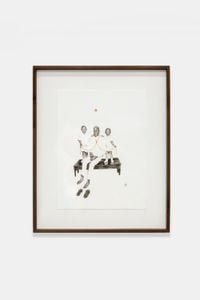
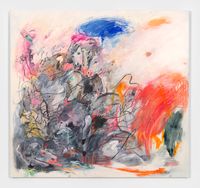
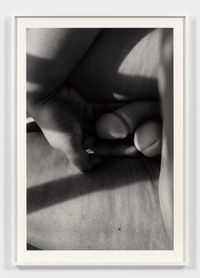
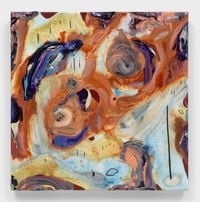
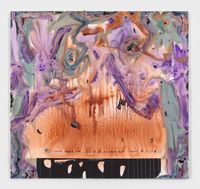
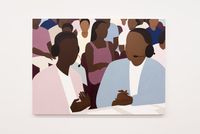
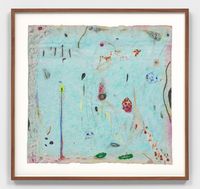
Andrew Kreps Gallery is pleased to announce Body Language, a group exhibition including six international artists whose work reflects on the human body. In their diverse practices, the artists included do not utilise the body for its physical form, but instead, as a conduit to explore both internal and political dimensions. Acknowledging that our bodies are constantly subject to cultural, and identity-based readings, the artists in the exhibition utilise these preconceptions in order to explore the body's political dimensions, and to encourage deeper understandings of its humanity.
In Sara Issakharian's (b. 1983, Tehran, Iran) work, ghostly, chimerical figures are embellished with vibrant colours and marks that waver between disciplined, figurativeillustration and frustrated outbursts of childlike, violent scribbling. Issakhraian's expressionistic imagery dwells on adversarial relationships such as predator and prey, aggression and calmness, and light and dark—terms that the artist uses to describe her own subjects. While these dichotomies characterise Issakharian's aesthetic sensibility, they extend to form a contemplation of her ambivalent feelings toward her native Iran, a contradictory mix of longing and anger. Sara Issakharian completed her MFA in painting at the New York Academy of Art in 2015. She was awarded the 2014 inaugural New YorkAcademy of Art Residency in Moscow, Russia, and in 2015 she was part of the first-round award winners of the Art Olympia prize, Japan. Issakharian's first exhibition at TanyaLeighton, Los Angeles, There's a whole life in that, in knowing that the sun is there, opened in2021.
Manuel Mathieu (b. 1986, Port-au-Prince, Haiti) blends figuration and abstraction in his work to explore the intersection of racial, geographical, and cultural identities. Workingwith muted and pastel colours, Mathieu manipulates paint by employing techniques such as scratching, rubbing, and layering—at times adding tape and chalk to the canvas surface—to create the ghostly figures and varied textures that characterise his paintings. This process becomes a vehicle for Mathieu to contemplate legacies of trauma—both personal and collective— calling for a revisitation of the past in order to relieve ongoing trauma in the present. Mathieu lives and works in Montreal. Exhibitions of Mathieu's work includeManuel Mathieu: World Discovered Under Other Skies, The Power Plant, Toronto, Canada;Manuel Mathieu: Survivance, Montreal Museum of Fine Arts, Montréal, Canada; The OtherSide of Now: Foresight in Contemporary Caribbean Art, Pérez Art Museum Miami, FL, USA;Over My Black Body, curated by Eunice Bélidor and Anaïs Castro, Université du Québec à Montréal, Canada; Manuel Mathieu: Nobody Is Watching, Kavi Gupta, Chicago, IL, USA; and_Manuel Mathieu: Wu Ji_, HdM Gallery, Beijing, China. Mathieu has been invited to the artist residency at the Art House in Sonoma, CA, in 2021.
Cassi Namoda (b. 1988 Maputo, Mozambique) is a painter and performance artist who explores the intricacies of social dynamics through vivid scenes that intermingle the heartfelt with the absurd, the quotidian with the cosmic, the joyous with the macabre.Born in Maputo to a Mozambican mother and American father, Namoda uses her work to negotiate the intricacies of mixed cultural heritage, intricacies that reflect the wider cultural dynamics of a formerly colonised nation in an increasingly globalised world. Recent solo exhibitions include Mendes Wood DM, São Paulo; Goodman Gallery, Johannesburg; Pippi Houldsworth, London; Nina Johnson Gallery, Miami; and François Ghebaly, Los Angeles. Namoda's work has been included in exhibitions at Caribbean Cultural Center AfricanDiaspora Institute, New York; Museum of Contemporary African Diasporan Arts, NewYork; CFHILL, Stockholm; and Library Street Collective, Detroit. She lives and works inNew York.
Thenjiwe Niki Nkosi's (b. 1980, New York) practice spans multiple mediums including film, installation, painting and performance. In her paintings, clean, geometric blocks depict scenes of people and architecture in the artists' signature colour palette of calming pastel tones. Nkosi uses oil on canvas, carefully layering her compositions over time in a processs he likens to meditation. In contrast to the tranquil aesthetic of her work, Nkosi's practice confronts complex and often chaotic notions of identity, race, power, memory, migration, and athleticism. In 2020, Nkosi had a solo exhibition at Stevenson, Johannesburg. Group and collaborative exhibitions include Mixed Company at the Norval Foundation, CapeTown, South Africa, 2021, FIVE, Don't Ask Me Where I'm From, Aga Khan Museum, Toronto,2020, NIEPODLEGŁE, Women, Independence and National Discourse, Museum of ModernArt, Warsaw, 2018, Moving Stills – Affective Archives, Mumok Cinema, Vienna, 2018, Art/Afrique, le nouvel atelier, Fondation Louis Vuitton, Paris, 2017, Kabbo ka Muwala, The Girl'sBasket, National Gallery of Zimbabwe, Harare, 2016.
Antonio Obá (b.1983 in Ceilândia, Brazil) investigates the influence and contradictions within the cultural construction of Brazil, giving rise to an act of resistance and reflection on the idea of national identity. Obá utilises icons present in Brazilian culture as allusions to racial and political identity; these iconic historical and sometimes religious subjects are explored within his sculpture, painting, installations, and performance. Obá's own body is central to his research, questioning the eroticization of the black male body and construction of his own identity. His works have been included in exhibitions such asCarolina Maria de Jesus, um Brasil para os brasileiros, IMS Paulista (2021); Enciclopédia Negra, Pinacoteca do Estado de São Paulo (2021); TUYMANS – CAHN – OBA, Bourse deCommerce – Pinault Collection, Paris (2021); Possédé·e·s, MO.CO, Montpellier (2020); 36º Panorama da Arte Brasileira, MAM, São Paulo (2019); Histórias Afro-Atlânticas, MASP / Tomie Ohtake, São Paulo (2018); Arte Democracia Utopia - quem não luta tá morto, MAR,Rio de Janeiro (2018); Pele de Dentro, Mendes Wood DM, New York (2018); Pipa Prize2017, Museu de Arte Moderna, Rio de Janeiro (2017); entre, Casa da América Latina,Brasília (2016); My body is a cage, Galeria Luciana Caravello, Rio de Janeiro (2016);ONDEANDAAONDA, Museu Nacional da República, Brasília (2015); OCUPAÇÃO, Elefante Centro Cultural, Brasília (2014).
Elle Pérez (b. 1989, Bronx, New York) centres their own personal connections to individuals, community, and place in their work, creating a palpable sense of familiarity in their photographs. Rather than stand outside looking in as other photographers might, Pérez works through their creative process as a friend, a lover, an intimate participant. 'Intimacy intrigues me with its mysteries,' the artist has said. 'The ties between my gender identity, kink, sexuality, pleasure, and pain are all interwoven. Instead of attempting to untangle them, I work within these complexities.' Pérez lives and works in New York City.Recent solo exhibitions include: Forum 84, Carnegie Museum of Art, Pittsburgh, 2021, Host,Commonwealth and Council, Los Angeles, 2021, from sun to sun, Public Art Fund, NewYork, 2019, Diablo, MoMA PS1, New York, 2018. and In Bloom, 47 Canal, New York, 2018.Pérez's work has been included in group exhibitions at the Renaissance Society, Chicago;Barbican Centre, London; Brooklyn Museum, New York; and the Whitney Museum ofAmerican Art, New York.
Press release courtesy Andrew Kreps Gallery.
55 Walker Street
New York, 10013
United States
www.andrewkreps.com
+1 212 741 8849
+1 212 741 8163 (Fax)
Tues - Sat, 10am - 6pm